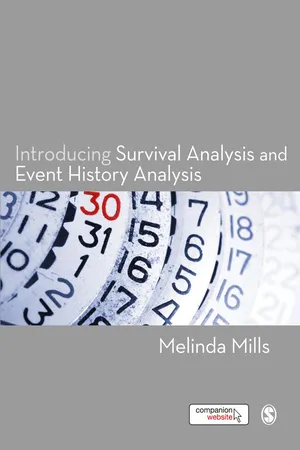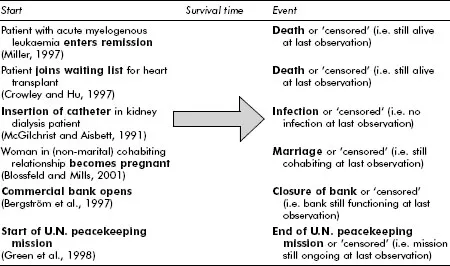![]()
1
The fundamentals of survival and event history analysis
Objectives of this chapter
After reading this chapter, the researcher should be able to:
- Define, recognize and describe the fundamental concepts and terminology used in survival and event history analysis.
- Recognize and describe the reasons why we use these methods and the types of problems that can be solved.
- Define and understand different types of censored and truncated data and different types of censoring.
- Define and recognize a density, survivor and hazard function.
- Describe the relationship between a density, survivor and hazard function.
- Be able to argue why it is necessary to use survival and event history models and their added value.
- Recognize the different types of survival and event history models and classes.
Introduction: what is survival and event history analysis?
1.1 Survival and event history analysis is an umbrella term for a collection of statistical methods that focus on questions related to timing and duration until the occurrence of an event. The models examine the hazard rate, which is the conditional probability that an event occurs at a particular time interval (t). In other words, we examine how long it takes until the event of interest occurs. It is useful to note that survival models are actually just regression models with somewhat different likelihood estimators than OLS (ordinary least-squares regression). Students who know something about regression should therefore have little difficulty understanding survival models.
An event may take many forms, such as an organ transplant, marriage, birth, death, political revolution or bank merger. Due to fact that many research questions concern timing and duration, this method appeals to multiple scientific disciplines. The techniques described in this book are often referred to as survival analysis in biostatistics, medical science and epidemiology, reliability analysis in engineering, duration models within economics, and event history analysis within sociology, demography, psychology and political science.
The goal of this book is to introduce these methods in an accessible, practical and engaging manner, starting from basic terminology and ranging to the most cutting-edge techniques used in the field today. Written for accessibility, this book will appeal to students and researchers who want to understand the basics and apply these methods without getting entangled in the mathematical and theoretical technicalities. Readers are offered a blueprint for their entire research project from research question, study design and data preparation to model selection and diagnostics, allowing them to independently master these advanced methods.
This book is written from the perspective of an applied researcher, with numerous examples and hands-on exercises, making it suitable as both a self-learning text or textbook within a course. Readers are provided with guidelines and suggestions on how to prepare data, run various types of models and enhance the expression of results with impressive graphics. Exercises within the body of the text are shown using the powerful and free computer program R, with Appendices and on-line material replicating some of the analyses using Stata (Appendix 2) and reference to SPSS and SAS on the companion web site to this book http://www.gmw.rug.nl/~millssurvivaleha.
This chapter begins by describing the fundamental concepts and terminology of these techniques, which is useful for beginners and serves as the foundation for the rest of the book. There is a sizeable amount of terminology related to these models that might be new for some researchers. Readers can therefore also refer to the glossary at the end of this book for a quick reference to the definitions of key terms. The mathematical expressions and relation of statistical functions are then presented in a manner that requires only a basic background in mathematics and statistics. We then turn to the logic of why it is necessary to use these types of models with certain data and research problems. The final section provides a brief overview of the different types of survival and event history models, which simultaneously serves as an overview of this book.
Key concepts and terminology
1.2 In survival and event history analysis, the dependent variable (also sometimes referred to as the response or outcome) is the hazard rate, which is the conditional probability that an event occurs at a particular time interval (t). In order to obtain statistical estimates of effects on this time to an event, most hazard rate results need to be transformed. Therefore, the dependent variable is a rate. The goal of these models is not only to examine the effects on the time until an event occurs, but also to assess the relationship of survival time to explanatory variables. Explanatory variables (also often referred to interchangeably as covariates or independent variables) assess the impact of certain characteristics (e.g. receiving treatment, size of tumour, level of education) on the dependent variable. As we will explore in the chapters that follow, these variables may be fixed or time-varying. Fixed variables do not change across time and include static variables such as sex or place of birth. Time-varying variables have values that change over time such as age, labour force experience or size of a tumour.
The classic example of an event is death. The occurrence of an event is often referred to as a failure, usually attributed to fact that the event is death or disease. As Table 1.1 illustrates, an event could also be an infection, marriage, ‘death’ of a bank or the end of a United Nations peacekeeping mission. (The topic of censoring shown in this table is described shortly.) Another way to understand survival is in terms of risk. Take the following question for example, given that an individual has remained in remission from cancer for three years, what is the risk that he or she will experience a relapse within each unit of time?
Survival and event history analysis is highly interdisciplinary and used extensively in epidemiology and health sciences. This includes the study of leukaemia, heart transplant survival and infections of kidney dialysis patients, primary biliary cirrhosis, the effects of air pollution on mortality or AIDS (e.g. Geskus, 2000; Pope et al., 1995). In the social sciences, there are also numerous applications such as the study of organizational change (Hannan and Carroll, 1981), changes in hate crime law (Grattet et al., 1998), social insurance legislation (Usui, 1994), many applications in political science (see Box-Steffensmeier and Jones, 1997), social movements and the evolution of right-wing movements (Olzak, 1989), job mobility (Mills et al., 2006), marriage (Blossfeld and Mills, 2001) and union decline (Western, 1995).
Table 1.1 Examples of survival analysis showing starting time and event status
Since we are concerned with analysing the time to the occurrence of an event, time is an essential aspect of these models and can be measured in diverse units, such as seconds, days, weeks, months or years. The duration or time that it takes before an event occurs is referred to as survival time. It is the time that a person or other unit of analysis (e.g. bolt in a machine, bank, political regime) ‘survives’ the specified duration. It is also often interchangeably referred to as a spell, episode, interval, waiting time, exposure time, risk period or duration.
The time axis may be continuous or discrete. If the time of the event is known precisely, it can be measured on a continuous scale (e.g. seconds, days, months). If the time units are unknown within larger units of years or decades, discrete-time methods are often used (Allison, 1982, 1984; Singer and Willet, 2003b). Discrete-time methods are therefore used when we have imprecise measurements and only know that the event occurred within a particular interval (e.g. within a year), but not the exact time; this is discussed in more detail in Chapter 9. In both continuous- and discrete-time models, the risk of the event occurring at time t is being modelled. Whereas the dependent variable in a continuous-time model is a hazard rate, in a discrete-time model it is the odds (if modelled using standard logit/probit models). The necessary precision of the timing of the event is highly dependent on the research question and often related to data restrictions. Although most processes occur in continuous time, they are often measured in discrete time, resulting in many event history models applying the discrete-time approach. Continuous-time models include the exponential survival model and the Cox semi-parametric model (Cox, 1972, 1975; Cox and Oakes, 1984). Results from discrete-time and continuous-time methods will be virtually the same in most models; furthermore, discrete-time models can be used to approximate continuous-time models (Allison, 1982; Yamaguchi, 1991).
These terms provide the basic foundations for simple models, but later chapters will also examine more complex topics such as frailty and recurrent events, competing risks and multistate models and modelling entire trajectories, defined in more detail at the end of this chapter. Models are generally divided into non-parametric, semi-parametric and parametric models, also described within the last section.
Censoring and tr...

